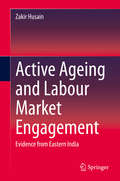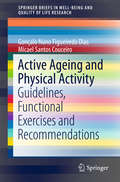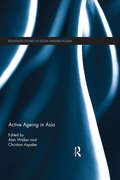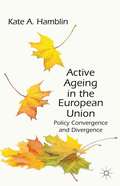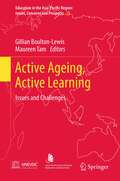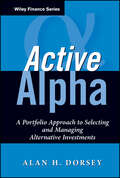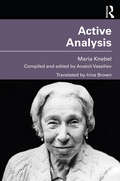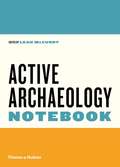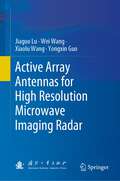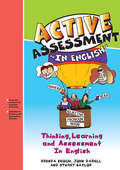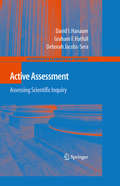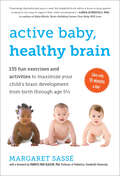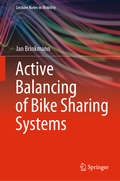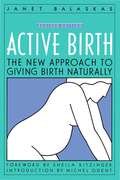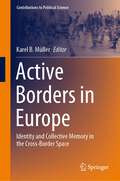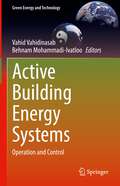- Table View
- List View
Active Ageing and Labour Market Engagement: Evidence from Eastern India
by Zakir HusainThe book provides an interesting analysis of the time-use data to examine the extent to which active ageing is occurring in India. It also synthesizes data from the National Sample Survey Office All India Survey and another survey undertaken in Kolkata, Bhubaneswar, and Ranchi (capital cities of East Indian states) to examine the role of the aged in the Indian Society. Nearly all countries in the world are experiencing an important issue of ageing. India faces its own set of challenges with its aging population due to the absence of a social security system—the shifting family dynamics questions the contribution of the elderly to the family in every aspect. Econometric models have been used in the book to study gender differences and variations across socio-economic conditions, correlating them to the contribution of the aged to their families and the extent of active ageing. The book broadens the understanding on the aged and facilitates their integration in the society so that they can age more actively. Active Ageing and Labour Market Engagement offers an analytical perspective to professionals, researchers, and policy makers interested in gerontology.
Active Ageing and Physical Activity: Guidelines, Functional Exercises and Recommendations (SpringerBriefs in Well-Being and Quality of Life Research)
by Gonçalo Nuno Figueiredo Dias Micael Santos CouceiroThis book presents an analysis of active ageing and physical activity from a multidisciplinary perspective. With descriptions of exercises, adequately illustrated with pictures, this book shows that regular physical activity reduces the prevalence of chronic diseases associated with ageing, as well as the risk of morbidity and mortality of the elderly. It confirms that exercise programs minimize the psychomotor decline, prevent the loss of functionality, inability and dementia, and foster significant gains in health and well-being, leading to increased quality of life of the elderly.
Active Ageing in Asia (Routledge Studies in Social Welfare in Asia)
by Alan Walker Christian AspalterEast Asian societies are changing rapidly, and one of the most important facets of this transformation is population the ageing. of society. "Active ageing" is one of the few concepts available today to effectively address the problems arising from a highly-aged and, particularly in East Asia, fast-ageing society, offering a new social policy paradigm to redirect and innovate new social policies, particularly social services, social transfers, social regulations and laws, towards more investment in and support of the fast rising number of olderelderly citizens. This book focuses on the experiences of East Asian societies where active ageing has been implemented. It presents a thorough analysis of the concept of active ageing and its potential and problems of implementations in different stages of development in East Asia, whilst providing theoretical clarity to, and broadening the concept of, active ageing. Further, the country-focused case studies explore how to design, pursue, measure and evaluate social policies, highlight the problems related to the implementation of the concept of active ageing in social policy and outline the practical implications of active ageing theory forin policy making. Active Ageing in Asia will appeal to students and scholars of social and public policy, social work, gerontology and health and social administration, as well as to policy makers working in the field.
Active Ageing in the European Union
by Kate A. HamblinThis book explores the adoption of 'active ageing' policies by EU15 nations and the impact on older peoples' work and retirement policy options. Policies examined include unemployment benefits, active labour market policies, partial pension receipt, pension principles, early retirement and incentives for deferral.
Active Ageing, Active Learning: Issues and Challenges (Education in the Asia-Pacific Region: Issues, Concerns and Prospects #15)
by Gillian Boulton-Lewis Maureen TamThis book is concerned with the general issues of ageing, learning and education for the elderly and then with the more specific issues of why, how and what elders want to learn. This monograph consists of 10 chapters written by various internationally renowned researchers and scholar-practitioners in the field.
Active Alpha
by Alan H. DorseyPraise for Active Alpha"Active alpha is the quest for every sophisticated investor. This book covers all of the key alpha sources currently mined by active managers, reduces the complexity of the subject, and helps the investor get started in the right direction."-Mark Anson, Chief Executive Officer, Hermes Pensions Management Ltd."Long-held traditional methods for investing large portfolios are giving way to new processes that are designed to improve productivity and diversification. These changes find their locus in the sometimes overly mysterious world of absolute return strategies. In this book, Alan Dorsey demystifies that new world and provides a guiding pathway into the future of professional portfolio management. This is an important read for any investor who plans to succeed going forward."-Britt Harris, Chief Investment Officer, Teacher Retirement System of Texas"With great lucidity, Alan Dorsey's book, Active Alpha, fills an important void by identifying the relevant institutional features of this complex subject and by providing a unifying analytic framework for understanding and constructing portfolios of alternative assets. For anyone investing in the alternative class, from the new student to the experienced practitioner, Active Alpha is a necessary read. I am recommending it to everyone I know with such an interest, and it is destined to become a much thumbed reference on my shelf."-Steve Ross, Franco Modigliani Professor of Financial Economics, Sloan School, MIT
Active Analysis
by Maria KnebelActive Analysis combines two of Maria Knebel’s most important books, On Active Analysis of the Play and the Role and The Word in the Actor’s Creative Work, in a single edition conceived and edited by one of Knebel's most famous students, the renowned theatre and film director, Anatoli Vassiliev. This is the first English translation of an important and authoritative fragment of the great Stanislavski jigsaw. A landmark publication. This book is an indispensable resource for professional directors, student directors, actors and researchers interested in Stanislavski, directing, rehearsal methods and theatre studies more generally.
Active Anti-Roll Bar Control Design for Heavy Vehicles
by Olivier Sename Peter Gaspar Vu Van Tan Trong Tu DoThis book provides a comprehensive overview of active anti-roll bar systems on heavy vehicles as one of the most effective solutions for improving the roll stability of these vehicles. Due to the characteristics of these vehicles with heavy loads and high center of gravity, the possibility of roll instability occurs frequently and causes serious consequences for human life, vehicles, and traffic infrastructure. The book gives readers an in-depth survey of the roll instability characteristics of heavy vehicles such as single-unit trucks with rigid and flexible frames, and tractor semi-trailers. It then introduces an active anti-roll bar system, the electro-hydraulic actuators which use control methods such as LQR optimal and H∞ robust controller design. This work introduces a new control method, which is a combination of robust control with the linear parameter varying system (H∞/LPV). The validation of the new hybrid method is carried out using the nonlinear truck model from the TruckSim® software to assess the roll stability of heavy vehicles in order to limit the rollover accident. A number of examples are provided to illustrate the research results, which helps the readers have a practical and easy approach that can be applied to other active anti-roll bar systems for most forms of transport vehicles in general. This book caters to academics and practitioners who are interested in active anti-roll bar systems for the typical heavy vehicle available worldwide.
Active Archaeology Notebook
by Leah McCurdyThe Active Archaeology Notebook offers effective and fun activities for the archaeology classroom. Conceived by a team of instructors from the SAA Curriculum Committee under the direction of Leah McCurdy (University of Texas at Arlington), every activity has been class tested and is designed to demonstrate key concepts in archaeology. The Notebook is ideal for instructors looking for diverse and active ways to teach archaeology.
Active Array Antennas for High Resolution Microwave Imaging Radar
by Wei Wang Jiaguo Lu Xiaolu Wang Yongxin GuoThis book highlights the application of active array antennas in high-resolution microwave imaging radar systems. It introduces the basic principles, analytical methods, and performance parameters of active array antennas to achieve low profile, high efficiency, and lightweight. The book systematically elaborates the architecture, analysis, and engineering practice to achieve wideband, multi-band, multi-polarization, and common aperture in active array antennas. It explores hotspot technologies of digital array antennas, microwave photonic array antennas, and active packaging antennas. By presenting over 300 illustrations and diagrams, including schematic diagrams, block diagrams, relation diagrams, and breakdown drawings, the book enables a thorough understanding of the antenna array microsystem as the advanced phase of active array antennas and the direction of future R&D. The book is a good reference source for researchers and engineers interested in the engineering and implementation of microwave imaging radar systems and antenna technology.
Active Assessment for Science: Thinking, Learning and Assessment in Science
by Anne Goldsworthy Brenda Keogh Stuart NaylorEverybody seems to be talking about assessment for learning. This book shows how to do it. Using a highly creative approach it explains in detail how assessment, thinking and learning can be integrated in science lessons. More than 30 different assessment techniques are described, with each one illustrated for two different age ranges.Concise teachers' notes for each technique explain:what the approach ishow you use it for assessmenthow you can manage it in the classroomhow it helps with learning.Electronic versions of the activities are provided on the accompanying downloadable resources.
Active Assessment in English: Thinking Learning and Assessment In English
by Brenda Keogh John Dabell Stuart NaylorEverybody seems to be talking about Assessment for Learning. This book shows you how to do it.The thinking behind the highly influential ‘Assessment for Learning’ approach is translated into usable and practical strategies for all those teaching literacy in primary and secondary classrooms.The authors show how thinking, learning and assessment can be linked together in a creative and integrated fashion, so that thinking promotes learning, learning enables assessment to take place and assessment acts as a stimulus to both thinking and learning. Concise teachers’ notes for a broad range of dynamic techniques explain for each:what the approach ishow you use it for assessment how you can manage it in the classroomhow it helps with learning.Downloadable resources are included with all of the activities and ideas that can be used on Interactive Whiteboards. Active Assessment for English will prove inspiring reading for all literacy teachers at primary and secondary levels, LEA advisers and inspectors.
Active Assessment: Assessing Scientific Inquiry (Mentoring in Academia and Industry #2)
by David I. Hanauer Debbie Jacobs-Sera Graham F. HatfullThe book is designed to provide a theoretical introduction to the field of active assessment, a practical guide to the development of assessment tools for scientific inquiry and a case study of a specific development and implementation process of assessment in a scientific inquiry program. As currently designed the book would have two sections: the first, theoretical and practical developing the concepts of how assessment is developed and implemented and the second section, a case study from research work conducted in the outreach program of the Bacteriophage Institute of Pittsburgh. The book is designed for a wide market of scientists involved in scientific education laboratory work. As with the original research project, this book breaks new ground in the area of scientific education and assessment and at this current time there is no book or research monograph that explicates a serious, comprehensive approach to the assessment of scientific inquiry. It is important to note that according to all the central bodies involved in science education (see the National Research Council's standards for science education) that the use of scientific inquiry is the preferred method of teaching science. Accordingly a book of this type should provide an important service for all active scientific inquiry programs in that it presents for the first time a concept and method for assessing scientific inquiry on the undergraduate and graduate levels. This book could provide an interesting answer to this situation of a required educational context without developed methodologies for evaluation.
Active Baby, Healthy Brain: 135 Fun Exercises And Activities To Maximize Your Child's Brain Development From Birth Through Age 5 1/2
by Margaret Sassé Frances Page Glascoe Georges McKailMovement, play, and active exploration in the first five years of a child’s life are essential to the development of his or her body and brain Now Active Baby, Healthy Brain presents 135 massages, exercises, and activities that engage your child’s love of play while also stimulating his or her brain development in multiple areas, including: Balance Cross-pattern movement Visualization Vestibular (inner ear) stimulation Laterality Fine and gross motor skills Each activity is presented on its own page with step-by-step instructions, appealing illustrations, and illuminating sidebars. The detailed instructions tell you exactly how to do each activity, as well as how to incorporate toys, music, dance, and games. No single activity takes more than two minutes, and all that’s required is ten minutes a day. More than thirty years in the making, Active Baby, Healthy Brain is an indispensable guide for everyone who is raising a child or who interacts with preschoolers.
Active Balancing of Bike Sharing Systems (Lecture Notes in Mobility)
by Jan BrinkmannThis book reports on an operational management approach to improving bike-sharing systems by compensating for fluctuating demand patterns. The aim is to redistribute bikes within the system, allowing it to be “actively” balanced. The book describes a mathematical model, as well as data-driven and simulation-based approaches. Further, it shows how these elements can be combined in a decision-making support system for service providers. In closing, the book uses real-world data to evaluate the method developed and demonstrates that it can successfully anticipate changes in demand, thus supporting efficient scheduling of transport vehicles to manually relocate bikes between stations.
Active Biology
by Ruta Demery Robert RitterActive Biology has fascinating challenges that ask you to use your creativity, interests, and expertise to complete challenges in the same way professionals do. You will learn about the incredible variety of organisms that inhabit the earth and how they have adapted to their environment. You will investigate competition among organisms and the process of natural selection. You will discover the factors that affect population size. And you will understand that the extinction of one organism can affect an entire ecosystem.
Active Birth - Revised Edition
by Janet BalaskasAn inspirational and instructive guide to those who want to give birth through their own efforts and to take full control of the birth.
Active Borders in Europe: Identity and Collective Memory in the Cross-Border Space (Contributions to Political Science)
by Karel B. MüllerThis book explores how identities, public spheres and collective memories are being transformed in cross-border areas, contributing to the broad sociological context of Europeanization. Offering case studies on the German-Czech-Austrian, and Czech-Polish-German borderlands, the book introduces original primary data on cross-border cooperation. This data is interpreted using the concept of active borders, which approaches borders as a source of multicultural competence and cognitive capacity. In turn, the authors argue that Europeans need to treat borders, both territorial and symbolic, as specific cultural forms. Active borders allow an unprecedented level of cross-border cooperation and integration, and foster a better understanding of differences, rather than re-embedding them or constructing others. Accordingly, the authors contend that active borders promote more dynamic, open and resilient societies, and represent crucial prerequisites for the success of the European integration project.
Active Building Energy Systems: Operation and Control (Green Energy and Technology)
by Behnam Mohammadi-Ivatloo Vahid VahidinasabThis book provides a comprehensive study on state-of-the-art developments in the control, operation, and market participation of active buildings (ABs). Active buildings can support the broader energy system by intelligent integration of renewable-based energy technologies for heating, cooling, electricity, and transport. This important reference analyzes the key features of modern control and operation techniques applied to these systems. Contributions from an international team of experts present practical methods with evidence and case studies from applications to real-world or simulated active buildings. Sample computer codes and analytical examples aid in the understanding of the presented methods. The book will support researchers working on the control and operation of buildings as an energy system, smart cities and smart grids, and microgrids, as well as researchers and developers from the building and energy engineering, economic, and operation research fields.Provides an in-depth review of building-level energy systems technologies;Covers codes, standards, and requirements for active building control systems;Includes sample computer code and analytical examples.
Active Cancellation of Probing in Linear Dipole Phased Array (SpringerBriefs in Electrical and Computer Engineering)
by Hema Singh Rakesh Mohan Jha N. Bala AnkaiahIn this book, a modified improved LMS algorithm is employed for weight adaptation of dipole array for the generation of beam pattern in multiple signal environments. In phased arrays, the generation of adapted pattern according to the signal scenario requires an efficient adaptive algorithm. The antenna array is expected to maintain sufficient gain towards each of the desired source while at the same time suppress the probing sources. This cancels the signal transmission towards each of the hostile probing sources leading to active cancellation. In the book, the performance of dipole phased array is demonstrated in terms of fast convergence, output noise power and output signal-to-interference-and noise ratio. The mutual coupling effect and role of edge elements are taken into account. It is established that dipole array along with an efficient algorithm is able to maintain multilobe beamforming with accurate and deep nulls towards each probing source. This work has application to the active radar cross section (RCS) reduction. This book consists of formulation, algorithm description and result discussion on active cancellation of hostile probing sources in phased antenna array. It includes numerous illustrations demonstrating the theme of the book for different signal environments and array configurations. The concepts in this book are discussed in an easy-to-understand manner, making it suitable even for the beginners in the field of phased arrays and adaptive array processing.
Active Chemistry
by Arthur Eisenkraft It'S About Time Gary Freebury American Institute of Chemical Engineers StaffActive Chemistry makes learning chemistry relevant, fun, and exciting. Chemistry is involved in every aspect of your life - from the way your body works to the things you like to do.
Active Chemistry
by Arthur EisenkraftThe highlighting features of this Chemistry text book are: Scenario, Chapter Challenge, Criteria, What Do You Think?, Investigate, Chem Talk, Chem Words, Checking Up, Reflecting on the Activity and the Challenge, Chemistry to Go, Preparing for the Chapter Challenge, Challenge Assessment, Chemistry at Work and Photos and Illustrations.
Active Chemistry: Project-Based Inquiry Approach
by Arthur Eisenkraft American Institute of Chemical EngineersNIMAC-sourced textbook
Active Citizenship and Community Learning (Empowering Youth and Community Work PracticeýLM Series)
by Carol PackhamThis book explores the role of the worker in facilitating participation, learning and active engagement within communities. Focusing on recent initiatives to strengthen citizen and community engagement, it provides guidance, frameworks and activities to help in work with community members, either as different types of volunteers or as part of self-help groups. Setting community work as an educational process, the book also highlights dilemmas arising from possible interventions and gives strategies for reflective, effective practice.
Active Citizenship and Disability
by Andrew Power Janet E. Lord Allison S. DeFranco Andrew Power Janet E. Lord Allison S. DefrancoThis book provides an international comparative study of the implementation of disability rights law and policy focused on the emerging principles of self-determination and personalisation. It explores how these principles have been enshrined in the United Nations Convention on the Rights of Persons with Disabilities and how different jurisdictions have implemented them to enable meaningful engagement and participation by persons with disabilities in society. The philosophy of 'active citizenship' underpinning the Convention - that all citizens should (be able to) actively participate in the community - provides the core focal point of this book, which grounds its analysis in exploring how this goal has been imagined and implemented across a range of countries. The case studies examine how different jurisdictions have reformed disability law and policy and reconfigured how support is administered and funded to ensure maximum choice and independence is accorded to people with disabilities.
